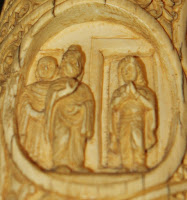 Āmrapālī (also known as "Ambapālikaka," "Ambapali," or "Amra") was a celebrated nagarvadhu (royal courtesan) of the Republic of Vaishali (located in present-day state of Bihar, India) in ancient proto-India around 500 BC [1, 2, 3].
Āmrapālī (also known as "Ambapālikaka," "Ambapali," or "Amra") was a celebrated nagarvadhu (royal courtesan) of the Republic of Vaishali (located in present-day state of Bihar, India) in ancient proto-India around 500 BC [1, 2, 3].Ambapali also won the title of rajnartaki (court dancer) [4]. Following the Buddha's Teachings, or Buddha-Dharma, she became an arahant, a fully enlightened disciple.
She is mentioned in the ancient Pali language texts and Buddhist traditions (āgama sutras), particularly in conjunction with the Buddha staying at her mango (amba) grove, Ambapali-vana, which she later donated to the Sangha (Monastic Order), where the Buddha taught the famous Ambapalika Sutra [5, 6, 7, 8].
The legend of Ambapali originated in the Buddhist Rebirth (Jataka) Tales some 1,500 years ago.
Early life
 |
| I can help it: I was born this way [by past karma] |
Ambapali was born around 600-500 BCE, to Mahanama and an unknown mother.
Etymologically, the variants of her name derive from a combination of two Sanskrit words, amra (Pali amba), meaning "mango," and pallawa, meaning "young leaves or sprouts" [9].
It is said that she was spontaneously born at the foot of a mango tree in one of the royal gardens in Vaishali — which resulted in her name [10].
Even as a young maiden, Ambapali was exceptionally beautiful and ethereal. It is said that a feudal lord by the name of Mahanaman was so enchanted by the young Ambapali's beauty that he abandoned his kingdom and moved to Ambara Village, a small hamlet in Vaishali in present-day Muzaffarpur [11].
As a courtesan
 |
| I will dance to please the royals. |
Vaishali was the capital city of the Licchavi tribe, one of the eight warrior (Pali khattiya, Sanskrit kshatriya) clans that had united to form the Vajjian confederacy [12].
The king was elected by an electoral college consisting of princes and nobles from the kshatriya clans. It was customary that the most beautiful women in the land, rather than marrying one man, dedicated themselves to the pleasure of many [13].
Ambapali grew up to be a lady of extraordinary charm and grace and was talented in many art forms [Geisha-girl style, a well education companion rather than someone simply providing sexual services][13].
Many young nobles desired her company. When King Manudev of Vaishali, saw Ambapali perform a dance in the city, he plotted to "own" her as a possession. He murdered Ambapali's childhood love and would-be-groom, Pushpakumar, on the day of their wedding.
Afterwards he made an official announcement declaring Ambapali as the "bride" of Vaishali — that is, the nagarvadhu ("royal courtesan"). She was also bestowed with the title of Vaishali Janpad Kalayani (Pali janapada kalyani "the belle of the land" of Vaisali), given to the most beautiful and talented girl of the kingdom for a period of seven years.
Ambapali had the right to choose her lovers, but according to the aforementioned custom, she could not be committed to any one man.
After being declared a nagarvadhu [14], her talent and beauty attracted so many men that the glory of Vaishali during this period is often attributed to Ambapali's fame [13]. The price to see Ambapali's art form was 50 karshapanas (Pali kahapanas, Bactrian gold from Afghanistan/Gandhara) per night, and her treasury grew much larger than the treasuries of some kings [13].
 |
| Who would objectify and judge kids' beauty? |
Legends associated with Ambapali
Ambapali and King Bimbisara
 |
| Carving of the Buddha and Ambapali |
King Bimbisara was a good musician. Before long, Ambapali and King Bimbisara fell in love. When she learned his true identity, Ambapali asked King Bimbisara to leave and cease his war.
King Bimbisara, smitten with love, did as she asked. In the eyes of the people of Vaishali, this incident made him a coward. Later, Ambapali bore him a son named Vimala Kondanna.
Ajatashatru (patricidal Prince Ajatasattu), King Bimbisara's son by Queen Chellana (according to Jain tradition) or Queen Kosala Devi (according to Buddhist tradition), later invaded Vaishali due to a dispute with his brothers.
He was so moved by her beauty that when Ambapali was imprisoned, he burned the whole of Vaishali. Almost everyone died in the massacre, except his beloved Ambapali, but when she saw the condition of her motherland, she renounced her love for him.
Ambapali and the Buddha
 |
| (We're not really Ambapali. We just play her in a Wisdom Quarterly play about her life). |
Ambapali attended his sermon at a nearby grove and was so deeply moved by it that she invited him for a meal at her quarters [17]. In other accounts, it is stated that the Buddha himself took shelter in her mango grove and was visited by Ambapali, who paid her obeisance to him and then extended the invitation [18].
The Buddha consented to her proposal of offering him a meal with silence, as was his custom [17]. On her way back, her chariot came face to face with that of the princely nobles of Vaishali who were also rushing to invite the Buddha to accept their offer of a meal with them.
 |
| The Buddha towering in neighboring Kapilavatthu |
It is then that she announced that the Buddha had already accepted her invitation and was coming to her house for a meal offering. The princes were upset and offered her gold in return for the privilege of hosting the Buddha, but she refused [18, 19].
The Buddha also turned them down when they asked him to accept their offer, having already committed to Ambapali's charitable donation.
The Buddha recognized her beauty and advised his disciples to be mindful in her presence because they easily become infatuated with her if they did not remain mindful [19]. [The Buddha advised monastics to imagine beautiful members of the other sex to be thought of as daughters or mothers, sons or fathers, so as not to succumb to their physical allure or beyond-physical charm.]
Ambapali received the Buddha with her retinue in her grand residence, which had been specially decorated for the occasion [20]. It was no less than the palace of any king [20], such was the wealth she had amassed.
At the conclusion of the meal offering, she offered to the Buddha and his spiritual community (Sangha) her entire property, including her mango groves, which became the venue for several sutras on mindfulness [20].
Awakened lay Buddhist
 |
| Why is the Buddha so famous throughout Asia? |
Soon thereafter, she renounced her position as courtesan and court dancer, accepted the Buddhist way, and remained an active supporter of the Buddha's Sangha. She dedicated her life to the service of the poor and the destitute [20].
On growing up, Ambapali's son, Vimala Kondanna, also became a Buddhist monk and a renowned Buddhist elder (thera) [16].For having followed the Buddha's Teachings, the Dharma, she had become a fully enlightened disciple. More
- Ambapālī (Dictionary of Pali Proper Nouns, palikanon.com)
- Amber Larson and Dhr. Seven (eds.), Wisdom Quarterly Wiki edit




















































































































































































































































No comments:
Post a Comment